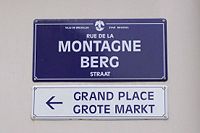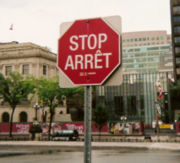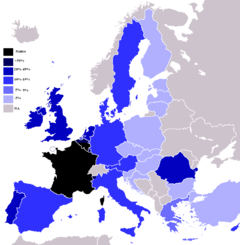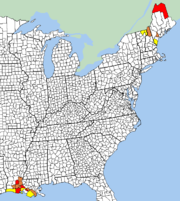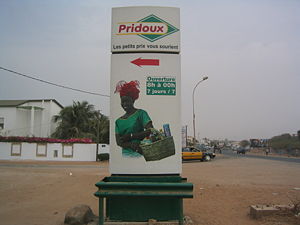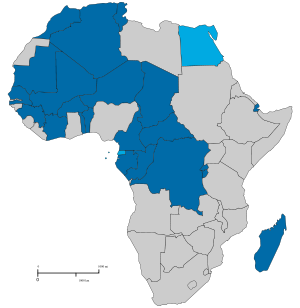French language
2008/9 Schools Wikipedia Selection. Related subjects: Languages
| French Français |
||
|---|---|---|
| Pronunciation: | /fʁɑ̃sɛ/ | |
| Spoken in: | Listed in the article | |
| Region: | Africa, Europe, Americas, Pacific, regions in Asia | |
| Total speakers: | Native: 65 to 130 million Total: estimates from 160 million to 500 million
|
|
| Ranking: | 9 (Native), total: 3 to 7 | |
| Language family: | Indo-European Italic Romance Italo-Western Western Gallo-Iberian Gallo-Romance Gallo-Rhaetian Oïl French |
|
| Official status | ||
| Official language in: | 30 countries Numerous international organizations |
|
| Regulated by: | Académie française (France) Office québécois de la langue française (Quebec, Canada) Conseil pour le développement du français en Louisiane (Louisiana) | |
| Language codes | ||
| ISO 639-1: | fr | |
| ISO 639-2: | fre (B) | fra (T) |
| ISO 639-3: | fra | |
|
Dark blue: French-speaking; blue: official language/widely used; Light blue: language of culture; green: minority |
||
| Note: This page may contain IPA phonetic symbols in Unicode. | ||
French (français, pronounced [fʁɑ̃sɛ]) is today spoken around the world by 72 to 130 million people as a native language, and by about 190 to 600 million people as a second or third language, with significant speakers in 54 countries. Most native speakers of the language live in France, where the language originated, Canada, Belgium and Switzerland.
French is a descendant of the Latin language of the Roman Empire, as are languages such as Portuguese, Spanish, Italian, Catalan and Romanian. Its development was also influenced by the native Celtic languages of Roman Gaul and by the Germanic language of the post-Roman Frankish invaders.
It is an official language in 29 countries, most of which form what is called in French La Francophonie, the community of French-speaking nations. It is an official language of all United Nations agencies and a large number of international organizations. According to the European Union, 129 million (26% of the 497,198,740) people in 27 member states speak French, of which 59 million (12%) speak it natively and 69 million (14%) claim to speak it as a second language, which makes it the fourth most spoken second language on the continent, after English, Russian and German respectively.
Geographic distribution
Europe
Legal status in France
Per the Constitution of France, French has been the official language since 1992 (although previous legal texts have made it official since 1539, see ordinance of Villers-Cotterêts). France mandates the use of French in official government publications, public education outside of specific cases (though these dispositions are often ignored) and legal contracts; advertisements must bear a translation of foreign words.
In addition to French, there are also a variety of regional languages. France has signed the European Charter for Regional Languages but has not ratified it since that would go against the 1958 Constitution.
Switzerland
French is one of the four official languages of Switzerland (along with German, Italian, and Romansh) and is spoken in the part of Switzerland called Romandie. French is the native language of about 20% of the Swiss population.
Belgium
In Belgium, French is the official language of Wallonia (excluding the East Cantons, which are German-speaking) and one of the two official languages—along with Dutch—of the Brussels-Capital Region where it is spoken by the majority of the population, though often not as their primary language. French and German are not official languages nor recognised minority languages in the Flemish Region, although along borders with the Walloon and Brussels-Capital regions, there are a dozen of municipalities with language facilities for French-speakers; a mirroring situation exists for the Walloon Region with respect to the Dutch and German languages. In total, native French-speakers make up about 40% of the country's population, the remaining 60% speak Dutch, the latter of which 59% claim to speak French as a second language. French is thus known by an estimated 75% of all Belgians, either as a mother tongue, as second, or as third language.
Monaco and Andorra
Although Monégasque is the national language of the Principality of Monaco, French is the only official language, and French nationals make up some 47% of the population.
Catalan is the only official language of Andorra; however, French is commonly used due to the proximity to France. French nationals make up 7% of the population.
Italy
French is also an official language, along with Italian, in the province of Aosta Valley, Italy. In addition, a number of Franco-Provençal dialects are spoken in the province, although they do not have official recognition.
Luxembourg
French is one of three official languages of the Grand Duchy of Luxembourg ;
the other official languages of Luxembourg are
- German
- Luxemburgish.
Luxemburgish is the natively-spoken language of Luxembourg ;
Luxembourg's education system is trilingual: the first years of primary school are in Luxembourgish, before changing to German, while secondary school, the language of instruction changes to French.
The Channel Islands
Although Jersey and Guernsey, the two bailiwicks collectively referred to as the Channel Islands, are separate entities, both use French to some degree, mostly in an administrative capacity. Jersey Legal French is the standardized variety used in Jersey.
The Americas
Legal status in Canada
About 7 million Canadians are native French-speakers, of whom 6 million live in Quebec, and French is one of Canada's two official languages (the other being English). Various provisions of the Canadian Charter of Rights and Freedoms deal with Canadians' right to access services in both languages, including the right to a publicly funded education in the minority language of each province, where numbers warrant in a given locality. By law, the federal government must operate and provide services in both English and French, proceedings of the Parliament of Canada must be translated into both these languages, and most products sold in Canada must have labeling in both languages.
Overall, about 13% of Canadians have knowledge of French only, while 18% have knowledge of both English and French. In contrast, over 82% of the population of Quebec speaks French natively, and almost 96% speak it as either their first or second language. It has been the sole official language of Quebec since 1974. The legal status of French was further strengthened with the 1977 adoption of the Charter of the French Language (popularly known as Bill 101), which guarantees that every person has a right to have the civil administration, the health and social services, corporations, and enterprises in Quebec communicate with him in French. While the Charter mandates that certain provincial government services, such as those relating to health and education, be offered to the English minority in its language, where numbers warrant, its primary purpose is to cement the role of French as the primary language used in the public sphere.
The provision of the Charter that has arguably had the most significant impact mandates French-language education unless a child's parents or siblings have received the majority of their own primary education in English within Canada, with minor exceptions. This measure has reversed a historical trend whereby a large number of immigrant children would attend English schools. In so doing, the Charter has greatly contributed to the "visage français" (French face) of Montreal in spite of its growing immigrant population. Other provisions of the Charter have been ruled unconstitutional over the years, including those mandating French-only commercial signs, court proceedings, and debates in the legislature. Though none of these provisions are still in effect today, some continued to be on the books for a time even after courts had ruled them unconstitutional as a result of the government's decision to invoke the so-called notwithstanding clause of the Canadian constitution to override constitutional requirements. In 1993, the Charter was rewritten to allow signage in other languages so long as French was markedly "predominant." Another section of the Charter guarantees every person the right to work in French, meaning the right to have all communications with one's superiors and coworkers in French, as well as the right not to be required to know another language as a condition of hiring, unless this is warranted by the nature of one's duties, such as by reason of extensive interaction with people located outside the province or similar reasons. This section has not been as effective as had originally been hoped, and has faded somewhat from public consciousness. As of 2006, approximately 65% of the workforce on the island of Montreal predominantly used French in the workplace.
The only other province that recognizes French as an official language is New Brunswick, which is officially bilingual, like the nation as a whole. Outside of Quebec, the highest number of Francophones in Canada, 485,000, excluding those who claim multiple mother tongues, reside in Ontario, whereas New Brunswick, home to the vast majority of Acadians, has the highest percentage of Francophones after Quebec, 33%, or 237,000. In Ontario, Nova Scotia, Prince Edward Island, and Manitoba, French does not have full official status, although the provincial governments do provide some French-language services in all communities where significant numbers of Francophones live. Canada's three northern territories ( Yukon, Northwest Territories, and Nunavut) all recognize French as an official language as well.
All provinces make some effort to accommodate the needs of their Francophone citizens, although the level and quality of French-language service vary significantly from province to province. The Ontario French Language Services Act, adopted in 1986, guarantees French language services in that province in regions where the Francophone population exceeds 10% of the total population, as well as communities with Francophone populations exceeding 5,000, and certain other designated areas; this has the most effect in the north and east of the province, as well as in other larger centres such as Ottawa, Toronto, Hamilton, Mississauga, London, Kitchener, St. Catharines, Greater Sudbury and Windsor. However, the French Language Services Act does not confer the status of "official bilingualism" on these cities, as that designation carries with it implications which go beyond the provision of services in both languages. The City of Ottawa's language policy (by-law 2001-170) allows employees to work in their official language of choice and be supervised in the language of choice.
Canada has the status of member state in the Francophonie, while the provinces of Quebec and New Brunswick are recognized as participating governments. Ontario is currently seeking to become a full member on its own.
Haiti
French is an official language of Haiti, although it is mostly spoken by the upper class, while Haitian Creole (a French-based creole language) is more widely spoken as a mother tongue.
French overseas territories
French is also the official language in France's overseas territories of French Guiana, Guadeloupe, Martinique, Saint Barthélemy, St. Martin and Saint-Pierre and Miquelon.
The United States
Although it has no official recognition on a federal level, French is the third most-spoken language in the United States, after English and Spanish, and the second most-spoken in the states of Louisiana, Maine, Vermont and New Hampshire. Louisiana is home to two distinct dialects, Cajun French and Creole French
Africa
A majority of the world's French-speaking population lives in Africa. According to the 2007 report by the Organisation internationale de la Francophonie, an estimated 115 million African people spread across 31 francophone African countries can speak French either as a first or second language.
French is mostly a second language in Africa, but in some areas it has become a first language, such as in the region of Abidjan, Côte d'Ivoire and in Libreville, Gabon. It is impossible to speak of a single form of African French, but rather of diverse forms of African French which have developed due to the contact with many indigenous African languages.
In the territories of the Indian Ocean, the French language is often spoken alongside French-derived creole languages, the major exception being Madagascar. There, a Malayo-Polynesian language ( Malagasy) is spoken alongside French. The French language has also met competition with English since English has been the official language in Mauritius and the Seychelles for a long time and has recently become an official language of Madagascar.
Sub-Saharan Africa is the region where the French language is most likely to expand due to the expansion of education and it is also there the language has evolved most in recent years. Some vernacular forms of French in Africa can be difficult to understand for French speakers from other countries but written forms of the language are very closely related to those of the rest of the French-speaking world.
French is an official language of many African countries, most of them former French or Belgian colonies:
In addition, French is an administrative language and commonly used though not on an official basis in Mauritius and in the Maghreb states:
Various reforms have been implemented in recent decades in Algeria to improve the status of Arabic relative to French, especially in education.
While the predominant European language in Egypt is English, French is considered to be a more sophisticated language by some elements of the Egyptian upper and upper-middle classes; for this reason, a typical educated Egyptian will learn French in addition to English at some point in his or her education. The perception of sophistication may be related to the use of French as the royal court language of Egypt during the nineteenth century. Egypt participates in La Francophonie.
French is also the official language of Mayotte and Réunion, two overseas territories of France located in the Indian Ocean, as well as an administrative and educational language in Mauritius, along with English.
Asia
Lebanon
French was the official language in Lebanon along with Arabic until 1941, the country's declaration of independence from France. French is still seen as an official language by the Lebanese people as it is widely used by the Lebanese, especially for administrative purposes, and is taught in schools as a primary language along with Arabic.
Southeast Asia
French is an administrative language in Laos and Cambodia. French was historically spoken by the elite in the leased territory Guangzhouwan in southern China. In colonial Vietnam, the elites spoke French and many who worked for the French spoke a French creole known as " Tây Bồi" (now extinct).
India
French has official status in the Indian Union Territory of Pondicherry, along with the regional language Tamil and some students of Tamil Nadu may opt French as their third or fourth language (usually behind English, Tamil, Hindi).
French is also commonly taught as third language in secondary school in most cities of Maharashtra State including Mumbai as part of the Secondary (X-SSC) and Higher secondary School (XII-HSC) certificate examinations.
Oceania
French is also a second official language of the Pacific Island nation of Vanuatu, along with France's territories of French Polynesia, Wallis & Futuna and New Caledonia.
Dialects
- Acadian French
- African French
- Aostan French
- Belgian French
- Cajun French
- Canadian French
- Cambodian French
- Guyana French (see French Guiana)
- Indian French
- Jersey Legal French
- Lao French
- Levantine French (most commonly referred to as Lebanese French, very similar to Maghreb French)
- Louisiana Creole French
- Maghreb French (see also North African French)
- Meridional French
- Metropolitan French
- New Caledonian French
- Newfoundland French
- Oceanic French
- Quebec French
- South East Asian French
- Swiss French
- Vietnamese French
- West Indian French
History
Sounds
Although there are many French regional accents, only one version of the language is normally chosen as a model for foreign learners, which has no commonly used special name, but has been termed français neutre (neutral French).
- Voiced stops (i.e. /b d g/) are typically produced fully voiced throughout.
- Voiceless stops (i.e. /p t k/) are described as unaspirated; when preceding high vowels, they are often followed by a short period of aspiration and/or frication. They are never glottalised. They can be unreleased utterance-finally.
- Nasals: The velar nasal /ŋ/ occurs only in final position in borrowed (usually English) words: parking, camping, swing. The palatal nasal /ɲ/can occur in word initial position (e.g. gnon), but it is most frequently found in intervocalic, onset position or word-finally (e.g. montagne).
- Fricatives: French has three pairs of homorganic fricatives distinguished by voicing, i.e. labiodental /f/–/v/, dental /s/–/z/, and palato-alveolar /ʃ/–/ʒ/. Notice that /s/–/z/ are dental, like the plosives /t/–/d/, and the nasal /n/.
- French has one rhotic whose pronunciation varies considerably among speakers and phonetic contexts. In general it is described as a voiced uvular fricative as in [ʁu] roue "wheel" . Vowels are often lengthened before this segment. It can be reduced to an approximant, particularly in final position (e.g. "fort") or reduced to zero in some word-final positions. For other speakers, a uvular trill is also fairly common, and an apical trill [r] occurs in some dialects.
- Lateral and central approximants: The lateral approximant /l/ is unvelarised in both onset (lire) and coda position (il). In the onset, the central approximants [w], [ɥ], and [j] each correspond to a high vowel, /u/, /y/, and /i/ respectively. There are a few minimal pairs where the approximant and corresponding vowel contrast, but there are also many cases where they are in free variation. Contrasts between /j/ and /i/ occur in final position as in /pɛj/ paye "pay" vs. /pɛi/ pays "country".
French pronunciation follows strict rules based on spelling, but French spelling is often based more on history than phonology. The rules for pronunciation vary between dialects, but the standard rules are:
- final consonants: Final single consonants, in particular s, x, z, t, d, n and m, are normally silent. (The final letters c, r, f and l, however, are normally pronounced.)
- When the following word begins with a vowel, though, a silent consonant may once again be pronounced, to provide a liaison or "link" between the two words. Some liaisons are mandatory, for example the s in les amants or vous avez; some are optional, depending on dialect and register, for example the first s in deux cents euros or euros irlandais; and some are forbidden, for example the s in beaucoup d'hommes aiment. The t of et is never pronounced and the silent final consonant of a noun is only pronounced in the plural and in set phrases like pied-à-terre. Note that in the case of a word ending d as in pied-à-terre, the consonant t is pronounced instead.
- Doubling a final n and adding a silent e at the end of a word (e.g. chien → chienne) makes it clearly pronounced. Doubling a final l and adding a silent e (e.g. gentil → gentille) adds a [j] sound.
- elision or vowel dropping: Some monosyllabic function words ending in a or e, such as je and que, drop their final vowel when placed before a word that begins with a vowel sound (thus avoiding a hiatus). The missing vowel is replaced by an apostrophe. (e.g. je ai is instead pronounced and spelt → j'ai). This gives for example the same pronunciation for l'homme qu'il a vu ("the man whom he saw") and l'homme qui l'a vu ("the man who saw him").
Orthography
- Nasal: n and m. When n or m follows a vowel or diphthong, the n or m becomes silent and causes the preceding vowel to become nasalized (i.e. pronounced with the soft palate extended downward so as to allow part of the air to leave through the nostrils). Exceptions are when the n or m is doubled, or immediately followed by a vowel. The prefixes en- and em- are always nasalized. The rules get more complex than this but may vary between dialects.
- Digraphs: French does not introduce extra letters or diacritics to specify its large range of vowel sounds and diphthongs, rather it uses specific combinations of vowels, sometimes with following consonants, to show which sound is intended.
- Gemination: Within words, double consonants are generally not pronounced as geminates in modern French (but geminates can be heard in the cinema or TV news from as recently as the 1970s, and in very refined elocution they may still occur). For example, illusion is pronounced [ilyzjɔ̃] and not [illyzjɔ̃]. But gemination does occur between words. For example, une info ("a news") is pronounced [ynɛ̃fo], whereas une nympho ("a nympho") is pronounced [ynnɛ̃fo].
- Accents are used sometimes for pronunciation, sometimes to distinguish similar words, and sometimes for etymology alone.
- Accents that affect pronunciation
- The acute accent (l'accent aigu), é (e.g. école—school), means that the vowel is pronounced /e/ instead of the default /ə/.
- The grave accent (l'accent grave), è (e.g. élève—pupil) means that the vowel is pronounced /ɛ/ instead of the default /ə/.
- The circumflex (l'accent circonflexe) ê (e.g. forêt—forest) shows that an e is pronounced /ɛ/ and that an o is pronounced /o/. In standard French it also signifies a pronunciation of /ɑ/ for the letter a, but this differentiation is disappearing. In the late 19th century, the circumflex was used in place of s where that letter was not to be pronounced. Thus, forest became forêt and hospital became hôpital.
- The diaeresis (le tréma) (e.g. naïf—foolish, Noël—Christmas) as in English, specifies that this vowel is pronounced separately from the preceding one, not combined and is not a schwa.
- The cedilla (la cédille) ç (e.g. garçon—boy) means that the letter c is pronounced /s/ in front of the hard vowels a, o and u (c is otherwise /k/ before a hard vowel). C is always pronounced /s/ in front of the soft vowels e, i, and y, thus ç is never found in front of soft vowels.
- Accents with no pronunciation effect
- The circumflex does not affect the pronunciation of the letters i or u, and in most dialects, a as well. It usually indicates that an s came after it long ago, as in hôtel.
- All other accents are used only to distinguish similar words, as in the case of distinguishing the adverbs là and où ("there", "where") from the article la and the conjunction ou ("the" fem. sing., "or") respectively.
- Accents that affect pronunciation
Grammar
French grammar shares several notable features with most other Romance languages, including:
- the loss of Latin's declensions
- only two grammatical genders
- the development of grammatical articles from Latin demonstratives
- new tenses formed from auxiliaries
French word order is Subject Verb Object, except when the object is a pronoun, in which case the word order is Subject Object Verb. Some rare archaisms allow for different word orders.
Vocabulary
The majority of French words derive from Vulgar Latin or were constructed from Latin or Greek roots. There are often pairs of words, one form being popular (noun) and the other one savant (adjective), both originating from Latin. Example:
- brother: frère / fraternel < from Latin FRATER
- finger: doigt / digital < from Latin DIGITVS
- faith: foi / fidèle < from Latin FIDES
- cold: froid / frigide < from Latin FRIGIDVS
- eye: œil / oculaire < from Latin OCVLVS
- inhabitants of the city Saint-Étienne are called Stéphanois
The last example, Saint-Étienne/Stéphanois, illustrates common practice for gentilics throughout France.
In some examples there is a common word from "vulgar" Latin and a more savant word from classical Latin or even Greek.
- Cheval—Concours équestre—Hippodrome
The French words which have developed from Latin are usually less recognisable than Italian words of Latin origin because as French developed into a separate language from Vulgar Latin, the unstressed final syllable of many words was dropped or elided into the following word.
It is estimated that 12% (4,200) of common French words found in a typical dictionary such as the Petit Larousse or Micro-Robert Plus (35,000 words) are of foreign origin. About 25% (1,054) of these foreign words come from English and are fairly recent borrowings. The others are some 707 words from Italian, 550 from ancient Germanic languages, 481 from ancient Gallo-Romance languages, 215 from Arabic, 164 from German, 160 from Celtic languages, 159 from Spanish, 153 from Dutch, 112 from Persian and Sanskrit, 101 from Native American languages, 89 from other Asian languages, 56 from Afro-Asiatic languages, 55 from Slavic languages and Baltic languages, 10 for Basque and 144 — about three percent — from other languages.
Numerals
The French counting system is partially vigesimal: twenty (vingt) is used as a base number in the names of numbers from 60–99. The French word for eighty, for example, is quatre-vingts, which literally means "four twenties", and soixante-quinze (literally "sixty-fifteen") means 75. This reform arose after the French Revolution to unify the different counting system (mostly vigesimal near the coast, due to Celtic [via Basque] and Viking influence). This system is comparable to the archaic English use of score, as in "fourscore and seven" (87), or "threescore and ten" (70).
Belgian French and Swiss French are different in this respect. In Belgium and Switzerland 70 and 90 are septante and nonante. In Switzerland, depending on the local dialect, 80 can be quatre-vingts (Geneva, Neuchâtel, Jura) or huitante (Vaud, Valais, Fribourg). Octante had been used in Switzerland in the past, but is now considered archaic. In Belgium, however, quatre-vingts is universally used.
Writing system
French is written using the 26 letters of the Latin alphabet, plus five diacritics (the circumflex accent, acute accent, grave accent, diaeresis, and cedilla) and the two ligatures (œ) and (æ).
French spelling, like English spelling, tends to preserve obsolete pronunciation rules. This is mainly due to extreme phonetic changes since the Old French period, without a corresponding change in spelling. Moreover, some conscious changes were made to restore Latin orthography:
- Old French doit > French doigt "finger" (Latin digitus)
- Old French pie > French pied "foot" (Latin pes (stem: ped-)
As a result, it is difficult to predict the spelling on the basis of the sound alone. Final consonants are generally silent, except when the following word begins with a vowel. For example, all of these words end in a vowel sound: pied, aller, les, finit, beaux. The same words followed by a vowel, however, may sound the consonants, as they do in these examples: beaux-arts, les amis, pied-à-terre.
On the other hand, a given spelling will almost always lead to a predictable sound, and the Académie française works hard to enforce and update this correspondence. In particular, a given vowel combination or diacritic predictably leads to one phoneme.
The diacritics have phonetic, semantic, and etymological significance.
- acute accent (é): Over an e, indicates the sound of a short ai in English, with no diphthong. An é in modern French is often used where a combination of e and a consonant, usually s, would have been used formerly: écouter < escouter. This type of accent mark is called accent aigu in French.
- grave accent (à, è, ù): Over a or u, used only to distinguish homophones: à ("to") vs. a ("has"), ou ("or") vs. où ("where"). Over an e, indicates the sound /ɛ/.
- circumflex (â, ê, î, ô, û): Over an a, e or o, indicates the sound /ɑ/, /ɛ/ or /o/, respectively (the distinction a /a/ vs. â /ɑ/ tends to disappear in many dialects). Most often indicates the historical deletion of an adjacent letter (usually an s or a vowel): château < castel, fête < feste, sûr < seur, dîner < disner. It has also come to be used to distinguish homophones: du ("of the") vs. dû (past participle of devoir "to have to do something (pertaining to an act)"; note that dû is in fact written thus because of a dropped e: deu). (See Use of the circumflex in French)
- diaeresis or tréma (ë, ï, ü, ÿ): Indicates that a vowel is to be pronounced separately from the preceding one: naïve, Noël. A diaeresis on y only occurs in some proper names and in modern editions of old French texts. Some proper names in which ÿ appears include Aÿ (commune in canton de la Marne formerly Aÿ-Champagne), Rue des Cloÿs (alley in the 18th arrondisement of Paris), Croÿ (family name and hotel on the Boulevard Raspail, Paris), Château du Feÿ (near Joigny), Ghÿs (name of Flemish origin spelt Ghijs where ij in handwriting looked like ÿ to French clerks), l'Haÿ-les-Roses (commune between Paris and Orly airport), Pierre Louÿs (author), Moÿ (place in commune de l'Aisne and family name), and Le Blanc de Nicolaÿ (an insurance company in eastern France). The diaresis on u appears only in the biblical proper names Archélaüs, Capharnaüm, Emmaüs, Ésaü and Saül. Nevertheless, since the 1990 orthographic rectifications (which are not applied at all by most French people), the diaeresis in words containing guë (such as aiguë or ciguë) may be moved onto the u: aigüe, cigüe. Words coming from German retain the old Umlaut (ä, ö and ü) if applicable but use French pronunciation, such as kärcher (trade mark of a pressure washer).
- cedilla (ç): Indicates that an etymological c is pronounced /s/ when it would otherwise be pronounced /k/. Thus je lance "I throw" (with c = [s] before e), je lançais "I was throwing" (c would be pronounced [k] before a without the cedilla). The c cedilla (ç) softens the hard /k/ sound to /s/ before the vowels a, o or u, for example ça /sa/. C cedilla is never used before the vowels e or i since these two vowels always produce a soft /s/ sound (ce, ci).
There are two ligatures, which have various origins.
- The ligature œ is a mandatory contraction of oe in certain words. Some of these are native French words, with the pronunciation /œ/ or /ø/, e.g. sœur "sister" /sœʁ/, œuvre "work (of art)" /œvʁ/. Note that it usually appears in the combination œu; œil is an exception. Many of these words were originally written with the digraph eu; the o in the ligature represents a sometimes artificial attempt to imitate the Latin spelling: Latin bovem > Old French buef/beuf > Modern French bœuf. Œ is also used in words of Greek origin, as the Latin rendering of the Greek diphthong οι, e.g. cœlacanthe "coelacanth". These words used to be pronounced with the vowel /e/, but in recent years a spelling pronunciation with /ø/ has taken hold, e.g. œsophage /ezɔfaʒ/ or /øzɔfaʒ/. The pronunciation with /e/ is often seen to be more correct. The ligature œ is not used in some occurrences of the letter combination oe, for example, when o is part of a prefix (coexister).
- The ligature æ is rare and appears in some words of Latin and Greek origin like ægosome, ægyrine, æschne, cæcum, nævus or uræus. The vowel quality is identical to é /e/.
French writing, as with any language, is affected by the spoken language. In Old French, the plural for animal was animals. Common speakers pronounced a u before a word ending in l as the plural. This resulted in animauls. As the French language evolved this vanished and the form animaux (aux pronounced /o/) was admitted. The same is true for cheval pluralized as chevaux and many others. Also castel pl. castels became château pl. châteaux.

